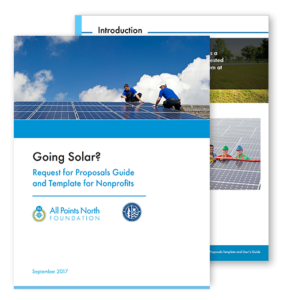Phase 1: Exploration
Determine baseline energy use.
Your solar installation may be able to help you reduce most if not all of the various components of your organization’s electricity bill. A basic way to determine your current energy usage – the baseline from which you will measure your savings after your solar installation is complete – is to collect electricity bills for the most recent 12 months. Most nonprofits and small businesses most likely will have a simple rate structure. However, depending on your utility and the type of rate structure you are on, you may need expertise from the outside to help you.

 A basic way to determine current energy usage is to collect electricity bills for the most recent 12 months. Some large facilities may have more than one electrical meter – be sure to separate data by meter, which should be labeled clearly on all bills. Most utilities may provide online access to your electricity usage. Electricity usage is measured in kWh (kilowatt hours). Bills may divide the total electricity charges in various ways. In some cases, there can be charges per kWh, separate charges for exceeding a specified peak electricity demand, a demand charge or separate charges for power factors that are below a specified amount plus fixed charges.
A basic way to determine current energy usage is to collect electricity bills for the most recent 12 months. Some large facilities may have more than one electrical meter – be sure to separate data by meter, which should be labeled clearly on all bills. Most utilities may provide online access to your electricity usage. Electricity usage is measured in kWh (kilowatt hours). Bills may divide the total electricity charges in various ways. In some cases, there can be charges per kWh, separate charges for exceeding a specified peak electricity demand, a demand charge or separate charges for power factors that are below a specified amount plus fixed charges.
Your solar installation may be able to help you reduce most or all of these charges. This analysis can start simply, but, depending on your utility and the type of electric tariff (rate structure) you are on, could call for some expertise from outside to understand more than an average cost/kwh. If your utility, like many, charges you for their Environmental Cost Compliance (cleaning-up their air and water pollution), it will appear on you bill as a cost/kWh and you can reduce this with every kWh you save or generate. Most nonprofits and small businesses most likely will have a simple rate structure. Be sure to note which tariff (e.g., Power and Light Medium) you have for your account.
All Points North Foundation provides grants for U.S.-based projects and initiatives that support our priorities: improving public middle school education and teacher training, and implementing effective solar programs and/or projects.
Have a U.S.-based project you’d like to discuss?

